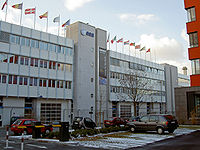
European Space Operations Centre
Encyclopedia

European Space Agency
The European Space Agency , established in 1975, is an intergovernmental organisation dedicated to the exploration of space, currently with 18 member states...
satellite
Satellite
In the context of spaceflight, a satellite is an object which has been placed into orbit by human endeavour. Such objects are sometimes called artificial satellites to distinguish them from natural satellites such as the Moon....
s and space probe
Space probe
A robotic spacecraft is a spacecraft with no humans on board, that is usually under telerobotic control. A robotic spacecraft designed to make scientific research measurements is often called a space probe. Many space missions are more suited to telerobotic rather than crewed operation, due to...
s. The centre is located in Darmstadt
Darmstadt
Darmstadt is a city in the Bundesland of Hesse in Germany, located in the southern part of the Rhine Main Area.The sandy soils in the Darmstadt area, ill-suited for agriculture in times before industrial fertilisation, prevented any larger settlement from developing, until the city became the seat...
, Germany
Germany
Germany , officially the Federal Republic of Germany , is a federal parliamentary republic in Europe. The country consists of 16 states while the capital and largest city is Berlin. Germany covers an area of 357,021 km2 and has a largely temperate seasonal climate...
. It is Mission Control for most of the space projects of the ESA. Since its creation in 1967, the centre has operated 60 European space missions. ESOC also houses the Ground Facilities Control Centre (GFCC) that is responsible for remote operation of the ESTRACK
ESTRACK
The European Space Operations Centre operates a number of ground-based space-tracking stations for the European Space Agency known as the European Space Tracking network. The stations support various ESA spacecraft and facilitate communications between ground operators and scientific probes such...
network of Ground Stations and antennas.
Currently ESOC is operating the following spacecraft: ERS-2
European Remote-Sensing Satellite
European remote sensing satellite was the European Space Agency's first Earth-observing satellite. It was launched on July 17, 1991 into a Sun-synchronous polar orbit at a height of 782–785 km.-Instruments:...
, XMM-Newton
XMM-Newton
The XMM-Newton is an orbiting X-ray observatory launched by ESA in December 1999 on a Ariane 5 rocket...
, the four Cluster
Cluster mission
Cluster II is a space mission of the European Space Agency, with NASA participation, to study the Earth's magnetosphere over the course of an entire solar cycle. The mission is composed of four identical spacecraft flying in a tetrahedral formation...
spacecraft, Envisat
Envisat
Envisat is an Earth-observing satellite. It was launched on 1 March 2002 aboard an Ariane 5 from the Guyana Space Centre in Kourou, French Guyana into a Sun synchronous polar orbit at an altitude of...
, INTEGRAL
INTEGRAL
The European Space Agency's INTErnational Gamma-Ray Astrophysics Laboratory is an operational Earth satellite, launched in 2002 for detecting some of the most energetic radiation that comes from space. It is the most sensitive gamma ray observatory ever launched.INTEGRAL is an ESA mission in...
, Mars Express
Mars Express
Mars Express is a space exploration mission being conducted by the European Space Agency . The Mars Express mission is exploring the planet Mars, and is the first planetary mission attempted by the agency. "Express" originally referred to the speed and efficiency with which the spacecraft was...
, Rosetta
Rosetta (spacecraft)
Rosetta is a robotic spacecraft of the European Space Agency on a mission to study the comet 67P/Churyumov–Gerasimenko. Rosetta consists of two main elements: the Rosetta space probe and the Philae lander. The spacecraft was launched on 2 March 2004 on an Ariane 5 rocket and will reach the comet by...
, Venus Express
Venus Express
Venus Express is the first Venus exploration mission of the European Space Agency. Launched in November 2005, it arrived at Venus in April 2006 and has been continuously sending back science data from its polar orbit around Venus. Equipped with seven science instruments, the main objective of the...
, GOCE
Gravity Field and Steady-State Ocean Circulation Explorer
The Gravity Field and Steady-State Ocean Circulation Explorer is an ESA satellite that was launched on March 17, 2009. It is a satellite carrying a highly sensitive gravity gradiometer which detects fine density differences in the crust and oceans of the Earth.GOCE data will have many uses,...
, Herschel
Herschel Space Observatory
The Herschel Space Observatory is a European Space Agency space observatory sensitive to the far infrared and submillimetre wavebands. It is the largest space telescope ever launched, carrying a single mirror of in diameter....
, Planck, and Cryosat-2
Recent high-profile missions that were controlled from ESOC include SMART-1
SMART-1
SMART-1 was a Swedish-designed European Space Agency satellite that orbited around the Moon. It was launched on September 27, 2003 at 23:14 UTC from the Guiana Space Centre in Kourou, French Guiana. "SMART" stands for Small Missions for Advanced Research in Technology...
and Huygens
Cassini-Huygens
Cassini–Huygens is a joint NASA/ESA/ASI spacecraft mission studying the planet Saturn and its many natural satellites since 2004. Launched in 1997 after nearly two decades of gestation, it includes a Saturn orbiter and an atmospheric probe/lander for the moon Titan, although it has also returned...
.
Projects under preparation include: LISA Pathfinder
LISA Pathfinder
LISA Pathfinder is the revised name for SMART-2, a NASA/ESA space probe to be launched in June 2013. SMART stands for Small Missions for Advanced Research in Technology. The aim of the LISA Pathfinder is to test technologies needed for the Laser Interferometer Space Antenna, a joint NASA/ESA...
, ADM-Aeolus
ADM-Aeolus
ADM-Aeolus, or, in full, Atmospheric Dynamics Mission Aeolus, is an ESA satellite that is due for launch in 2013.ADM-Aeolus will be the first equipment capable of performing global wind-component-profile observation and will provide much-needed information to improve weather forecasting.The Aeolus...
, SWARM
Swarm (ESA mission)
Swarm is a European Space Agency mission to study the Earth's magnetic field.The Swarm concept consists of a constellation of three satellites in three different polar orbits between 450 and 550 km altitude...
, the Sentinel series and Gaia.
Recently controlled through LEOP
LEOP
In Spacecraft Operations, The Launch and Early Orbit Phase is one of the most critical phases of a mission. Spacecraft operations engineers take control of the satellite after it separates from the launch vehicle up to the time when the satellite is safely positioned in its final orbit.During this...
, and then handed over to EUMETSAT was MetOp-A
MetOp
MetOp is a series of polar orbiting meteorological satellites operated by the European Organisation for the Exploitation of Meteorological Satellites. The satellites are all part af the EUMETSAT Polar System. It is intended to replace the soon to be retired TIROS network...
.
This centre is also responsible for the development of the technology infrastructure it requires to support existing and planned missions, including Space Control and Operations Software (SCOS 2000
SCOS 2000
The Satellite Control and Operation System 2000 is the generic satellite Mission Control System software infrastructure developed and maintained by the European Space Agency in collaboration with European industry and deployed for missions such as Radarsat 2, XMM Newton, Integral, MSG, Cryosat,...
), an adaptable software infrastructure for monitoring and controlling the various spacecraft.
History
Space science data handling has two aspects. Firstly, it requires the setting up of a network of tracking andtelemetry stations which can receive signals from spacecraft (ESTRACK). This network comprised four stations situated in the following locations:
- Redu (Belgium)
- Fairbanks (Alaska)
- Svalbard (Norway)
- Falkland Islands
Secondly, it requires a central facility which edits and processes the information from the tracking network. The facilities at the centre, initially labelled ESDAC (European Space Data Acquisition Centre), were essentially a large mainframe computer or computers, which was made available both to its in-house staff and to visiting scientists and fellows who wished to use them to analyse and study the recovered data. ESDAC was later renamed ESOC, the European Space Operations Centre. ESOC is located in Darmstadt (Germany). After the Bannier Report it gained overall executive authority for spacecraft operation. ESOC's director also became responsible for ESRANGE and for ESTRACK.

